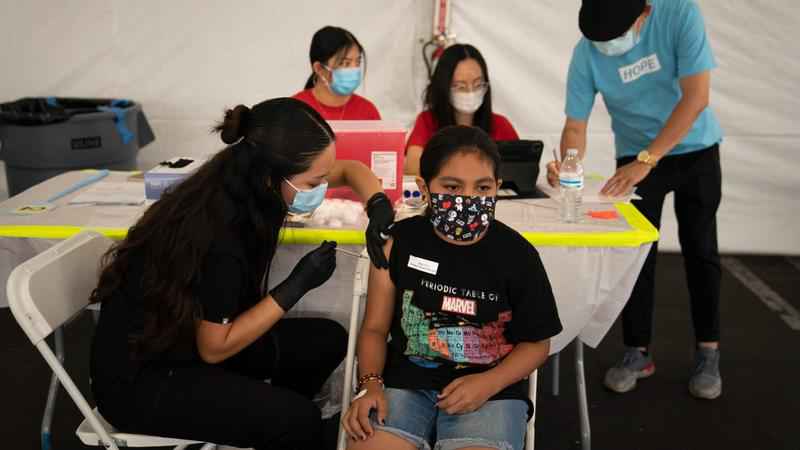US has enough COVID-19 vaccines for boosters, kids’ shots

In this Aug. 28, 2021, file photo, Mayra Navarrete, 13, receives the Pfizer COVID-19 vaccine from registered nurse, Noleen Nobleza at a clinic set up in the parking lot of CalOptima in Orange, Calif. With more than 40 million doses of coronavirus vaccines available, U.S. health authorities said they're confident both seniors and other vulnerable Americans seeking booster shots and parents anticipating approval of initial shots for young children will have easy access.[Jae C. Hong/Associated Press]
With more than 40 million doses of coronavirus vaccines available, U.S. health authorities said they’re confident there will be enough for both qualified older Americans seeking booster shots and the young children for whom initial vaccines are expected to be approved in the not-too-distant future.
The spike in demand — expected following last week’s federal recommendation on booster shots — would be the first significant jump in months. More than 70 million Americans remain unvaccinated despite the enticement of lottery prizes, free food or gifts and pleas from exhausted health care workers as the average number of deaths per day climbed to more than 1,900 in recent weeks.
Federal and state health authorities said current supply and steady production of more doses can easily accommodate those seeking boosters or initial vaccination, avoiding a repeat of the frustratingly slow rollout of COVID-19 vaccines across the country early this year.
“I hope that we have the level of interest in the booster … that we need more vaccines,” Colorado Gov. Jared Polis said Tuesday. “That’s simply not where we are today. We have plenty of vaccines.”
Robust supply in the U.S enabled President Joe Biden this week to promise an additional 500 million of Pfizer’s COVID-19 shots to share with the world, doubling the United States’ global contribution. Aid groups and health organizations have pushed the U.S. and other countries to improve vaccine access in countries where even the most vulnerable people haven’t had a shot.
Among the challenges states face is not ordering too many doses and letting them go to waste. Several states with low vaccination rates, including Idaho and Kansas, have reported throwing away thousands of expired doses or are struggling to use vaccines nearing expiration this fall.
While most vaccines can stay on the shelf unopened for months, once a vial is opened the clock starts ticking. Vaccines are only usable for six to 12 hours, depending on the manufacturer, according to the U.S. Food and Drug Administration.
Moderna vaccines come in vials containing 11 to 15 doses. Pfizer vials contain up to six doses and Johnson & Johnson vials five doses.
“We are going to see more doses that go unused over time,” said Wisconsin’s health secretary, Karen Timberlake. “They come in multidose files. They don’t come in nice, tidy individual single-serving packages.”
State health officials said they have tried to request only what health care providers and pharmacies expect to need from the federal supply. Those numbers have dwindled since the vaccines became widely available in early spring.
But U.S. officials — holding out hope that some of the unvaccinated will change their minds — are trying to keep enough vaccines in stock so all Americans can get them.
That balancing act is tricky and can lead to consternation around the globe as the U.S. sits on unused vaccines while many countries in places such as Africa can’t get enough vaccines.
“Somebody sitting in a country with few resources to access vaccines, seeing people in the U.S. able to walk into a pharmacy and get that vaccine and choosing not to, I’m sure that’s causing heartache,” said Jen Kates, senior vice president and director of global health and HIV policy for the Kaiser Family Foundation.
Dr. Marcus Plescia, chief medical officer of the Association of State and Territorial Health Officials, which represents the public health agencies of all 50 U.S. states, the District of Columbia and U.S. territories, said officials anticipate that on-hand doses of COVID-19 vaccines and manufacturers’ ability to supply more will meet needs across the country.
“I think states have tried to plan as if everybody’s going to be offered a booster,” he said, suggesting they will be overprepared for the more narrow recommendations issued by the FDA and the Centers for Disease Control and Prevention.
California, for example, estimated earlier this month that it would need to administer an extra 63 million doses by the end of 2022 — if initial shots for children under 12 were approved and boosters were open to everyone.
U.S. health officials late Thursday endorsed booster shots of the Pfizer vaccine for all Americans 65 and older — along with tens of millions of younger people who are at higher risk from the coronavirus because of health conditions or their jobs.
California, with nearly 40 million residents, has the lowest transmission rate of any state and nearly 70% of eligible residents are fully vaccinated. That leaves nearly 12 million people not vaccinated or not fully vaccinated.
Dr. Mark Ghaly, California’s health secretary, said the state will rely largely on pharmacies and primary care providers to give boosters to seniors while some large counties and health care groups will use mass vaccination sites.
In Pennsylvania, more than 67% of residents older than 18 are fully vaccinated. Alison Beam, acting secretary of health, said health authorities now have “two missions”: Continuing to persuade people to get vaccinated and serving those eager to receive a booster or initial shots.
“Pennsylvania is going to be prepared,” Beam said. "And we’re going to have the right level of vaccine and vaccinators to be able to meet that demand.”